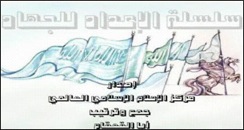
The main elements in this image are the white flags and the mounted horse. In the Islamic tradition, the Prophet Muhammad used the white flag to represent both the leader of the Muslim army and the first Muslim state. It usually bears the same inscription as the black flag, which is the Muslim proclamation of faith (the shahada, or the Islamic testimony of faith holding that there is no god but Allah and that Muhammad is his messenger). In jihadi propaganda, the white flag is commonly used synonymously with the black flag to evoke the Prophet and the idea of establishing an Islamic state, although the white flag has less militant connotations. The white also evokes notions of death, grief and mourning, as it is the color of shrouds. The horse and rider motif (on the right end side of the image) is common in jihadi visual propaganda. The rider emphasizes the element of human agency in jihad, and is a way to enhance the traditional symbol of a horse and flesh out notions of aggression and the call to jihad. The horse is an important symbol in both pre-Islamic Arabia and Islamic culture, as evidenced by pre-Islamic poetry, hadiths (prophetic traditions or reports) and other genres of literature ascribing horses with the positive qualities of chivalry and bravery in battle. Horses are also symbolic of the first generation of Muslims and that generation’s successful military campaigns, and thus are often employed to evoke specific Salafi religious sentiments with regard to the military victories of Muhammad and his companions, including the concept of jihad itself.
The caption reads: “silsilat al-i‘dad lil-jihad; isdar markaz al-i‘lam al-islami al’alami; jam‘ wa-tartib – abu al-qa‘qa” (“series on preparation for jihad; produced by the Global Islamic Media Center”). The individual named in the image (bottom line) is Abu al-Qa`qa`, who was suspected of playing a significant role in facilitating the entry of foreign fighters into Iraq from Syria. He was also accused of having links to both al-Qa’ida and Syrian intelligence.
 Skip to content
Skip to content
